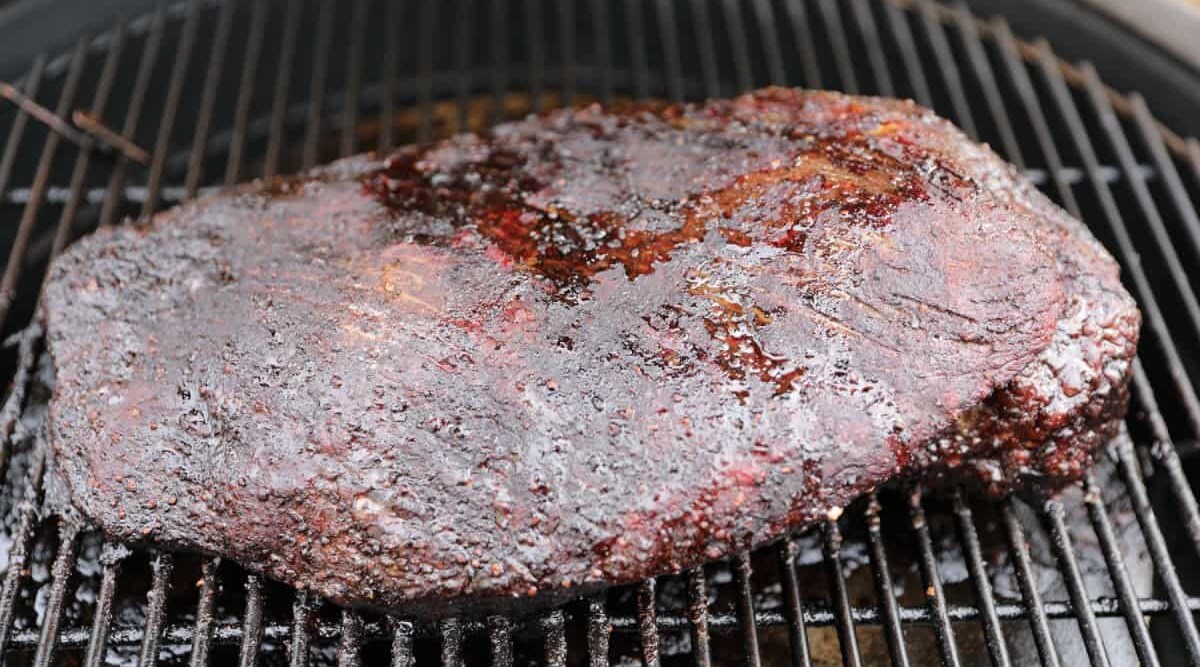
In this ultimate guide to the stall we answer all your questions including: What is the BBQ stall? What causes it? Can it be avoided, dodged, or minimized?
They say a watched pot never boils. This is, of course, not true — unless you forgot to turn the stove on. The point is it always feels like anything you’re waiting patiently for is never going to happen. Like expecting a package in the mail, or counting down to the first day of your vacation.
This feeling is all-too-familiar to anyone who likes to barbecue low ‘n’ slow or has a smoker. Whereas you can take a burger or steak from counter to grill to plate in mere minutes, something big like a rack of ribs or a brisket can be an all-day affair. Sure the results are worth it, but the anticipation is sweet agony.
And, just when you think you’re getting close to dining on succulent meat, it happens. The stall.
I have no data on this, but I’m sure the BBQ stall has caused more heart attacks, conniptions, and fits of rage than any other barbecue phenomenon.
Now, it’s time for me to quit stalling and get to the facts.
Jump to:
What is The BBQ Stall?
As if it wasn’t hard enough waiting hours for meat to smoke, you have to deal with the cruel phenomenon known variously as “the zone,” “the plateau,” and, most famously, “the stall.”
So what is it? It’s exactly what it sounds like.
When a large cut like a brisket or pork shoulder is smoking at low temperature, it will invariably heat up to about 150F and then stop.
It doesn’t matter that the smoker is set to 225F; that needle or digital readout ain’t moving. Or, if it does, it may actually drop a few degrees. Where’s the panic button???
How Long Does The Stall Last?
That’s the worst part — it seems like it’s never going to end.
The length of the stall depends on the size of the meat and a host of other variables. Many first-time smokers lose their minds and crank the heat, or transfer to a hot oven, and never see the back end of a stall.
A brisket stall or pork butt stall can last anywhere from 2-6 hours, but 4 is about average.
So, what on Earth could cause food in a hot grill or smoker to stop heating up?
Why Does the Stall Happen?
There have been numerous theories put forward over the years as to why the stall happens. They range from simple physics to alien abduction. (Ok, not really.)
The most likely candidates seemed to be collagen changing to gelatin inside the meat, fat rendering into a liquid state, or denaturing proteins.
The basis for these theories? That each process is heat-activated, therefore, steals heat from the cooking process. Once the suspect process ends, the heat can then go back to cooking.
Those are all very nice, scientific-sounding postulations.
Unfortunately, they’re all wrong.
The Real Science of The Stall
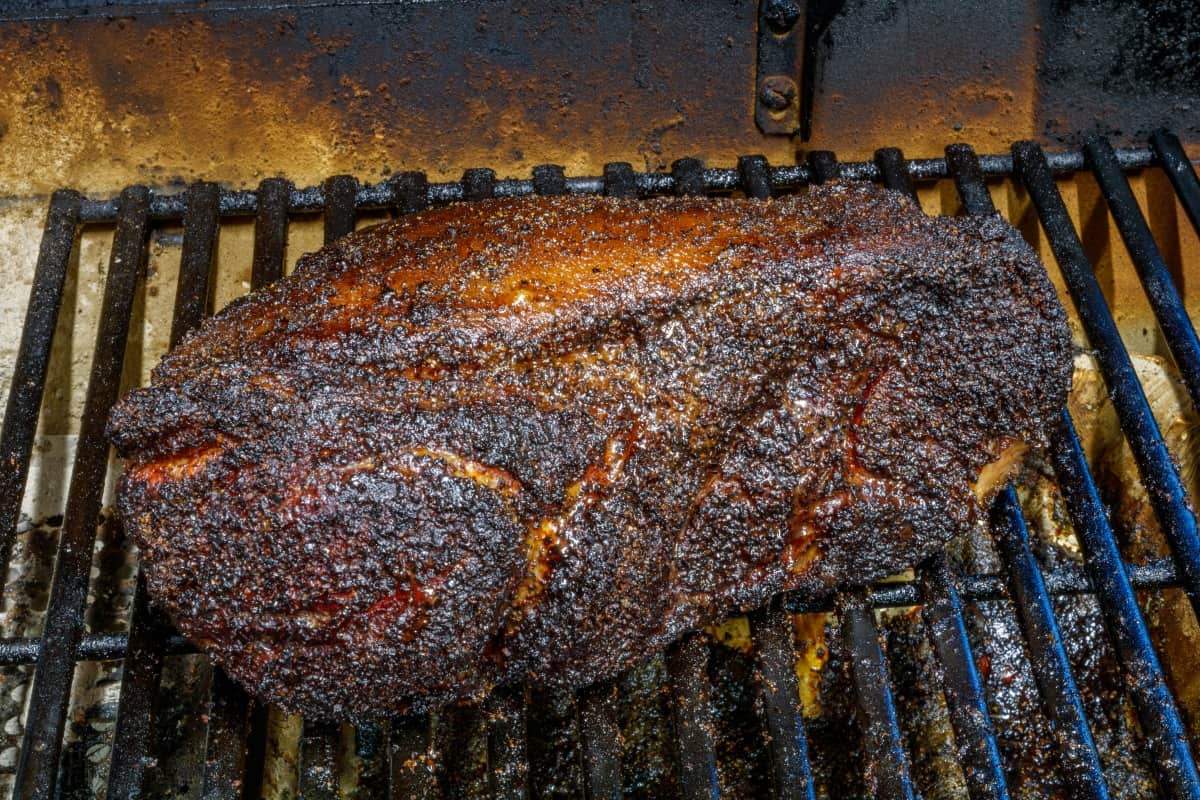
What’s actually going on is surprisingly simple. Put in the most basic terms, your meat is sweating.
As you no doubt know, your body sweats to keep you cool. The moisture on your skin evaporates, and evaporation causes cooling. The moisture on your skin absorbs heat from your body, and as it evaporates away, it takes some heat with it, cooling you. That’s why you can sit in a 180F sauna for 20 minutes without turning into bacon.
Of course, your meat is not trying to protect itself from the heat. It is quite dead. However, dead or alive, the physics are still the same. Moisture from the meat, in the form of retained water and other fluids, and liquefied fat, makes its way to the surface of the meat and evaporates in the heat.
The evaporation causes the surface of the meat to cool, or at least hold its temperature at a constant level, despite the higher temperature of the air inside the smoker or cooker.
Eventually, all the surface moisture disappears, and the evaporation/cooling process comes to an end. Then, and only then, will the temperature begin to climb again.
Here is a simple graph to illustrate the point. It’s not based on a specific cut or size but is a good visual representation of what’s going on.
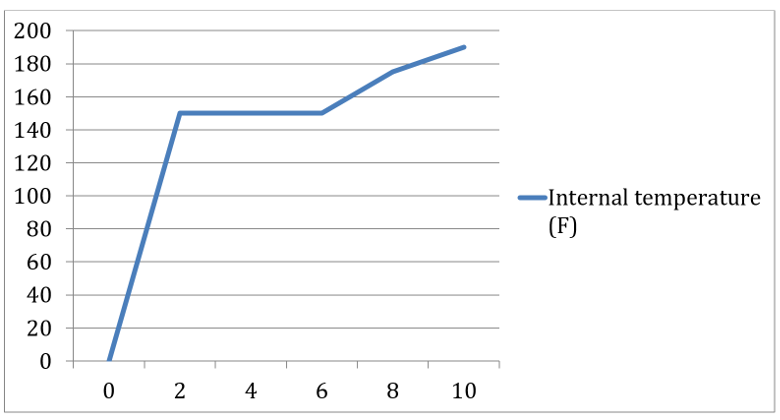
Here we see the temperature rising steadily for the first couple of hours until about 150F. From there it levels out and holds for many hours. Once the moisture is gone and evaporative cooling ends, the temperature climbs again until it reaches our target in and around 200F.
Many factors contribute to the length of the stall. The size and shape (and hence the surface area) of the meat play a role, as does the internal composition of the cut. The humidity outside will also factor in, so you may experience shorter stalls on dry days versus sticky ones.
How to Beat The Stall
Now that you know what the stall is, you understand that it will pass every time. Fortunately, only the moisture closest to the surface is drawn out for evaporation. Deep inside the cut, proteins, collagen, and fat greedily cling to reservoirs of moisture. Even if you wait out the stall, you still won’t dry out your meat.
Unfortunately, it’s hard to know how long that might take, making it very difficult to set dinner plans. Plus, who wants to stand around waiting when you could be eating mouth-watering brisket?
Here are a couple of ways you can “beat” the stall and speed up your cooking time.
Aluminum Foil/Texas Crutch
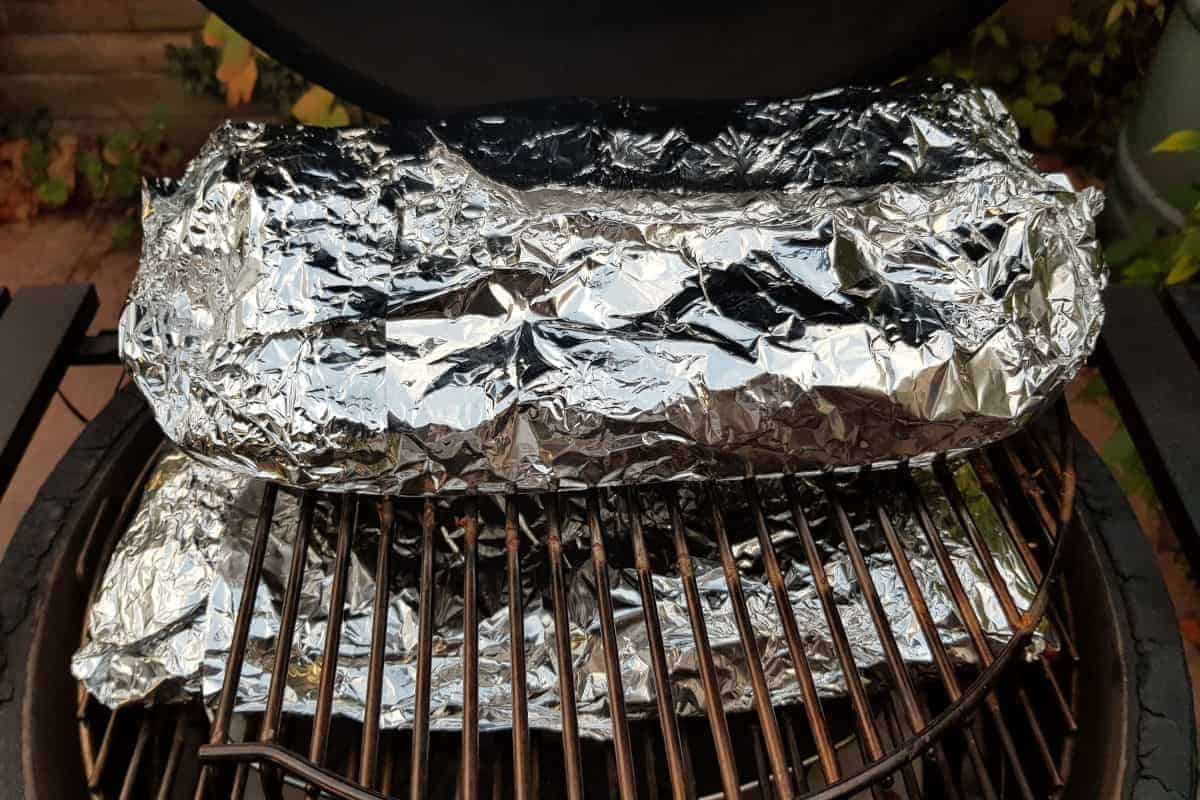
Texas Crutch must be one of the most famous terms in all of barbecue.
In a nutshell, the trick is to wrap your lovely meat in aluminum foil at just the right time, add a bit of fluid, and then stick it back in the cooker. (“I thought it was going to stall, so I let out the crutch!” You can use that one next time you’re looking for some grilling humor to amuse your guests.)
Of course, there’s a lot more to it than that. That’s why we have an entire article devoted to this critical topic. If you want to break away now and check it out, be our guest: A guide to the Texas Crutch.
Pink Butcher Paper
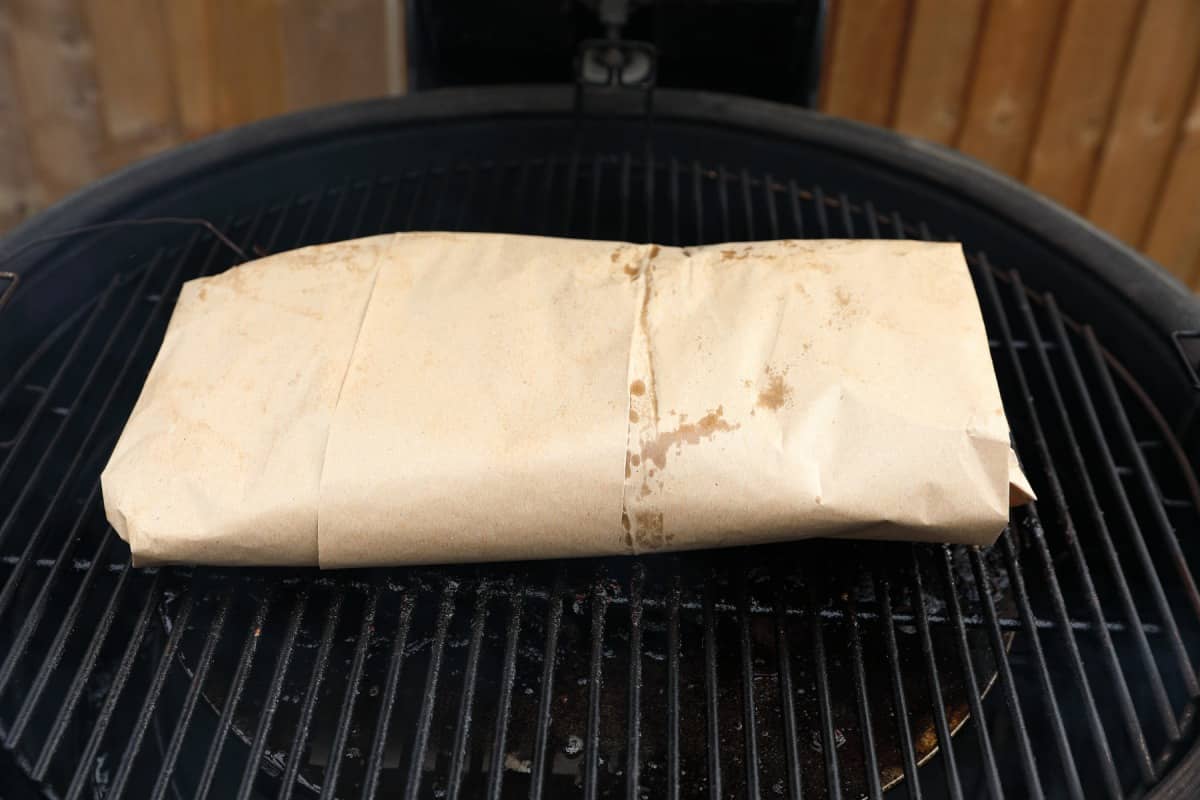
Using pink butcher paper is a bit like performing a Texas Crutch. (Sounds like a line-dance move, doesn’t it?) Following the same technique, you pull the meat out of the cooker at the beginning of the stall, wrap it up, and put it back.
The advantage of butcher paper over foil is it can breathe. Smoke and heat pass through, imparting flavor and building up the bark.
It’s not going to speed up cooking time quite as dramatically as foil, so you won’t quite “beat” the stall with pink butcher paper. But you will fight it to a tasty draw. Wrapping in pink butcher will speed the time taken to get through the stall by quite an amount.
Seal Your Smoker Tight
Most smokers lose plenty of heat and smoke to the outside environment. And if stuff is going out, that means stuff is going in, too. That includes moisture in the air.
If your smoker is tightly sealed (some electric smokers are pretty tight), you may experience considerably less stall than on a “drafty” cooker.
If you see obvious gaps in your smoker, you can fill them with gaskets and other high-temperature friendly products.
Be warned, though, that the results may be detrimental to the formation of bark on your meat.
Raising the Temperature
The stall has been shown to be a low-temperature phenomenon that is unique to low ‘n’ slow cooking. You never see this happening during a medium— or high-temperature cook.
With that in mind, some chefs are cranking it up as high as 300-350F, far above the traditional brisket or pork shoulder temperature of 225F. Anecdotal evidence suggests that this completely negates the stall and dramatically speeds up cooking time.
Although I am a bit skeptical of this method for smoking, anything is worth a try once, especially for 4-hour brisket.
Nothing is Going To Stop Us Now
The key to solving any problem is first to seek to understand it. Ok, that sounds like it’s right out of some awful self-help book, but it’s true. Now that you know what the stall is, the next time it happens, you will expect it and won’t panic.
We hope this explanation of the stall and the tips for getting past it prove useful, and that you have many successful low ‘n’ slow sessions in your future!
Got any friends fighting the stall, or know anyone who is just getting into low ‘n’ slow barbecue? Be a pal and send them to this article.
If you’re in the sharing mood, please share your thoughts and stories with us in the comments below. Tell us what you like and don’t like about the site. Reveal your barbecue secrets. You can even suggest topics you’d like to see covered. We’re real people here, folks, and we’re always ready to talk to our readers!
Thanks for stopping by, and may the good ‘cues be yours.
Happy grilling!


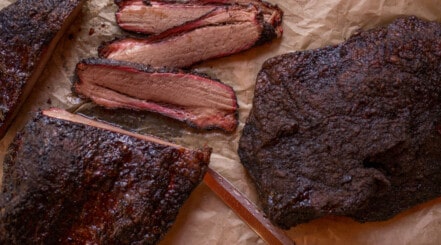

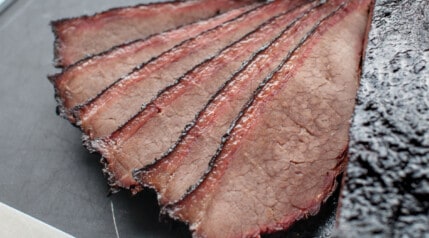
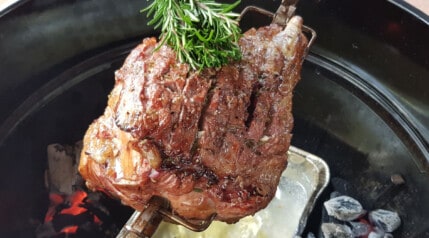
My elk sausage is stuck at 129 °F … Has been for 3 hours … Cabinet temp is 160 °F … Outside air temp is about 40 °F … I guess I am going to wait it out … Thanks for all the info you pass along.
Tom.
No worries, Tom. Nice to hear people find it useful.
Sounds mighty chilly there — Grilling whatever the weather 🙂
Thank you for explaining the stall. I’m new to wood pellet cooking and your article cleared up many questions I had about the length of time it takes to cook. I’d read advice on several websites to “wait the stall” but I had no idea why behind it. You cleared that up in a very interesting and easily relatable manner. I’ll definitely be checking out more of your articles.
Pork shoulder stalled at 170 degrees cooking at 225 after reading your article decided to crank it up to 340 shoulder temp started to climb in about a half hour finished the cook two hours later thank for your helpful articles
That’s great to hear, Leonard 🙂
I frequently do this with butts myself. Smoke at 225f for 3 or 4 hours, until a semi-decent bark has formed, then wrap and crank it up to 350f until it’s probe tender. For pulled pork I honestly cannot tell the difference at all between 225f all the way, or cranking it up like that.
I have tried similar with beef ribs before though and won’t be doing that again, haha. The collagens, connective tissues etc. just did not have time to render out, and though they were mostly probe tender, there weren’t half some chewy and dry bits.
So yes, great for pork butts, not so great for beef ribs!
I plan every pork butt and brisket cook anticipating a double stall, even though there is normally just one.
Planning for stalls takes all the stress out of not knowing when you’re going to be able to serve your friends and family the great meal you promised them.
Your best friend in planning these cooks are your cooler you put your meat in after it’s become buttah soft in your smoker of choice. Once it’s done, double wrap it in aluminum foil and put it in your preheated cooler. It will stay in the cooler safely for 4 hours.
I cook butts and briskets at 225 °F. I never wrap them while they are in the smoker. I never turn the heat up to speed through a stall. I never bother opening the lid on my smoker to see how my meat looks. Having smoked 100’s of these big hunks of meat, I already know what I’m going to see.
I’ve done many 14/16 hour “no peek” cooks by putting the meat in the cooker, installing leave-in temperature probes to track the interior temperature of the meat and the actual cooking temperature 2” from the meat. Once I have those steps done, and my cooking temperature stabilizes at 225 °F, I go to bed. The next day when I wake up, I check on my cooker, and it’s always at 225 °F because of my DigiQ Dx2 temperature regulator. During the day, I just go about my business without worrying about how my meat is cooking. Breakfast and/or a round of golf with friends is fine.
I start these cooks exactly 18 hours before the time I’ve told my friends and/or family when I’m going to serve them dinner. Both butts and briskets take 14/16 hours at 225 °F without wrapping them. When my meat gets to 195 °F, I check it with my Thermapen to see if it’s become buttah soft yet … Normally, that happens closer to 203°, though.
I’ve used this planning method for many years without getting an unanticipated surprise. Try it sometime, it’s very stress-free … Plus you ALWAYS serve your guests exactly on time.
Hi Breadhead,
Thanks for this, it’s some sound advice 🙂
I think they key is the auto-temp controller you mention (you have a DigiQ, I have the flame boss 300, so am on the same page somewhat) so you can sleep without worrying about the cook getting out of whack without you watching. Certainly a good investment for those who can stretch to buying one!
Thank You so very much! I am a first time smoker with an electric 30 inch Masterbuilt. About 5 hours into the process the temperature of my Pork Butt stalled at 152 degrees. I began to panic until I read Your experience and advice on the subject. I’m cooking at 225 degrees on a cold humid day here in the North East. Now I’m going to ride it out until the meat reaches 200.
Thanks again!
Best of luck … Hopefully the food turns out killer for you 🙂
Very interesting information never had tried to figure out what caused the Stall.
Thanks Corkey!
Ahhhhhh, the infamous stall! I’m going through it yet again today. I’ve got two briskets and two butts in the smoker. I use the pink butcher paper and love the results. On the brisket, it seems to render a juicier result. Keep on smokin’! Love the site.
2 briskets and 2 butts? Just dinner for one then? Haha. Epic cook, John, hope all goes well.
I tend to use pink butcher paper for wrapping too, unless I’m adding a liquid — which I rarely do — and then I use foil. The paper definitely keeps a better bark.
I’ve smokes whole hogs and now mostly butts for over 60 years. I guess time wasn’t as big an issue in my earlier years. About 20/30 years ago I started reading about the crunch and how to “beat” the stall. I did try it, but eventually I decided the issue was that I was planning wrong. Earlier writer noted to go ahead and plan for 18 hours. If you see trying to squeeze a full cook into 12 hours you are “stressing both the meat and yourselves”.
As noted save the wrap for when it is done, so it will rest and maintain temp until you are ready to serve the meat. I think this was easier when we didn’t have all the new temp gauges Etc. Use them but not to speed things up but to slow down your own stress. Love Charles
I honestly can’t argue with a thing you’ve said 🙂
It’s a symptom of modern life though I think: We’re all so busy — or at least feel so busy — all the time, and are always looking for ways to speed things up.
It can also be hard to be able to sit and manage a cook for that length of time, particularly if you have children and all the responsibility and time intensive things that come with it.
However, with the automatic temperature settings on electric and pellet smokers these days, as well as temperature controllers available for most charcoal grills and smokers, there’s no need to be present and managing things anymore, you can pretty much ‘set and forget’ and monitor things remotely from your smartphone, so that removes any time issues.
Personally, I much prefer a butt cooked right through without wrapping anyway, I like the deeper, chewier bark that adds further flavor and for me, a better texture when it’s distributed throughout the pulled pork.
Got a 13 lb brisket smoking in the electric smoker, and from 2am until 8am it’s at 175 °F going up and down a bit. Need this done by 11am, so am hoping the stall finishes soon.
I used a salt and pepper rub, 225 °F, started at 8pm planning for a 15h smoke. Will pull at 190 °F, but hoping for 200 °F.
It might be alright, but also may not be enough time, particularly to allow for resting time. Probably 50/50 as I’ve had some be done in 12 hours, some take 16 or more.
I’d see where it is when I got up in the morning, raise the smoker to between 260f and 275f if it’s not looking like it’ll be done in time. It won’t make much if any difference to the end product, but will speed things up.
Best of luck…let us know how you get on 🙂
Thank you for your article I have learned a lot
I’m in the middle of my first brisket ever. 12 lb on a Traeger 650, running 225 °F. I put it on at 12:30am, so I’m 10 hrs in so far. Temp has been stuck at 145 °F for hours now, getting nervous about drying it out, and can’t wait to wrap it. I have the butcher paper ready. Is it possible to have too much smoke flavor? Thanks, for all your info!
It’s possible you might have the probe tip in a fat pocket? Have you probed for temps in different places?
As far as a ‘too smoky flavor’, that’s a personal thing. Form some people you can certainly can, for others…no.
If you’re happy with the way the bark looks, you can wrap it now, it’ll be fine after that amount of time for sure.
Good article! Thanks, for the info.
Great article, thank you. I came here wondering if pork shoulder stalled. Definitely got my answer.
Personally, I love the stall when smoking a brisket, I always plan for an all day adventure and when it takes less time, I just savor the moment!
There’s worse ways to spend a day than with your feet up near a lit BBQ, with some friends, a few drinks and some music 🙂
One of my tricks for great pulled pork is injecting with either apple or apple cranberry juice (frozen concentrate only diluted 1:1. Not 1:3) 24 hrs in advance. Rub with your favorite rub and smoke in a disposable turkey roaster to catch the juices. Smoke till 205 degrees internal. Let rest 1-2 hours while taking the drippings and putting in the refrigerator until the fat solidifies….remove the fat. Place your pulled pork back on the smoker, gently adding more rub to taste while drizzling on the reserved juices. Taste constantly until enough rub is to your liking. Adding enough reserved drippings until you can “hear” the moisture when stirring. Enjoy
First time smoking in an electric. Did a couple of big pork shoulders. Stalled for 12 hours! Smoker won’t go higher than 275; I hate to wrap them and lose the bark. Should I just stick them in the oven and heat the house up?
I have been BBQing for decades, so know my fire, charcoal, mesquite, rubs, sauce, etc. But I am new to smoking.
I have an old Brinkmann BBQ that I am trying to make work with limited success. I guess I will have to succumb and buy a real smoker.
Maybe you could walk us newbies through an equipment article?
Types of smokers, grill/smoker combo, offset, tower, etc. Please stick to charcoal/wood as I will never go pellet or electric.
Thanks very much.
PS: Typing this while panicking at an internal temp of 129 on pork butt after 2 hours…
Hi, Jerry. We have an article you can check out on the different types of smokers. It discusses how they work, pros and cons of each type, and more. I would start there.
Thanks mark my 8 lb Boston butt has been stuck at 170 for about 3/4 hrs and I’m in st Augustine Fla
When adding a chunk of wood the smoke turns white. Eventually it goes back to the blue gray color. Is there a method to controlling this? Will the white smoke effect the meat? Any advice would be greatly appreciated. I am using a offset smoker.
Thank You,
Dennis
A little white smoke isn’t bad, and in some smokers is inevitable (such as with my Kamados for example.) What you can do to minimize this in an offset is to preheat the wood, typically by placing it on top of the firebox, where it heats though but does not ignite. This gets the wood hot before you use it, so it burns quicker once in the firebox, and enters into stage 3 of combustion sooner, creating the smoke we desire. See this article for details: Smoke and smoking wood 101.
Thanks for this article Mark. It was EXACTLY what I was looking for. Doing my first pork butt today (on an SNS Kettle) and though I anticipated the stall I wasn’t super clear on how to get through it despite hours of YouTube videos (which were super helpful, not knocking anyone) that mentioned temps, but not time. Currently stalled at 152 for the past 3 hours (grill at about 240) and just salivating for that rendered fat, pulled pork, deliciousness. Thanks again sir.
Man, that stall, you nailed it, took 14 hours to cook, but well worth it. Next time I’m going for the Texas crutch…..great job on writing!
I’ve just experienced the stall smoking a turkey and also smoking a Boston butt , I recently got a smoker with offset firebox and feel that may be my issue, my stalls are 4 plus hours , prior I was smoking with a charcoal cooker ( meat on on side heat on the other and never stalled !! Could it be the smoker?
Hi, Wayne. Never stalled? This can only be if you’ve been cooking so hot and fast that you blew through the stall without even knowing. Do you have a digital pit probe so can measure the temps where you are cooking?